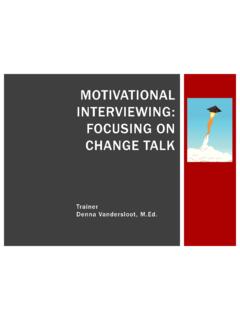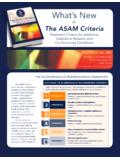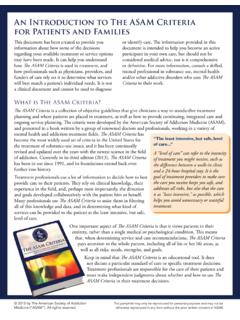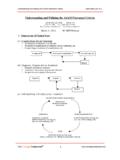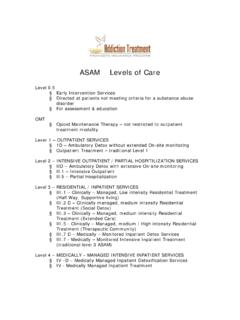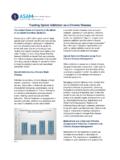Transcription of DSM-5 AND ASAM CRITERIA - attendicadd.com
1 DSM-5 AND ASAM CRITERIAP resented by Jaime Goffin, LCSWMODULE 1: GOALS & OBJECTIVES What is your experience with using ASAM and DSM 5 CRITERIA ? What are your learning expectations for today?GOAL FOR TRAINING To develop and/or enhance the knowledge and skills to make more informed and accurate clinical decisions and write concise clinical justifications for those decisions using the DSM-5 and ASAM CRITERIA Identify and explain rationale and benefits of using the ASAM CRITERIA to make patient placements Identify characteristics and differentiate between various levels of care Identify and differentiate between ASAM s six dimensions of assessment Identify information to formulate a dimension
2 Risk rating Learn how dimension risk rating and clinical justification directly drive treatment planningCRITICAL THINKING Practitioners who are willing to call into question the assumptions underlining their customary, habitual ways of thinking and acting, and are ready to think and act differently on the basis of critical IS NOT Designed to answer all of your questions regarding the assessment, placement and treatment of persons with addictive disorders Sufficient to make you competent in the use of ASAM CRITERIA , but rather an introduction to it.
3 Further practice, training and supervision is required to learn how to use the CRITERIA successfully. MODULE 2: CHALLENGES FACING THE in the collection of client of the interpretation of data collected for patient placement and treatment planning of appropriate evidence based, proven and effective treatment interventions to the client s identified implementation of evidenced based and implementation of policies and procedures to monitor the above. MODULE 3: RATIONALE & BENEFITS OF STANDARDIZED ASSESSMENT CRITERIAWHAT DOES THE RESEARCH SAY?
4 Clients that are mismatched to treatment have lower retention rates and poorer outcomes. Less treatment is NOTGood. More treatment is S HAPPENING IN SOME PROGRAMS Client s are being referred to wrong levels of care. Client s assessed are referred to, and treated in the agency conducting the assessment Assessments don t justify the recommendations being made. Clinical justifications are providedWHAT We asked 200 Counselors to make a patient placement decision and provide a clinical justification for that decision?
5 All given the same DO YOU THINK HAPPENED?BENEFITS OF USING EVIDENCE BASED CRITERIA Improve Performance and Treatment Outcomes Increase Motivation, Engagement and Retention Rates More Efficient and Effective Utilization Reviews Use of a common languageIMPORTANT! Tools and CRITERIA s are NOTsubstitutes for GOOD Clinical Judgment. Tools and CRITERIA s support, guide and enhance GOOD Clinical 4: ASAM CRITERIA The ASAM CRITERIA describes in detail an IDEAL continuum of care with the various services and interventions provide at each levels.
6 HISTORY: UNDERLYING PRINCIPLES CLINICAL CARE Complications-driven Treatment No diagnosis of Substance Use Disorder Treatment of Complications of the addiction with no continuing care Relapse Triggers treatment of complications only. , PROGRAM-DRIVEN TREATMENT Diagnosis determines treatment Treatment is the primary program and aftercare Relapse-triggers a repeat of the program , CLINICALLY-DRIVEN CLIENT-DIRECTED, OUTCOME INFORMEDGUIDING PRINCIPLES OF THE ASAM CRITERIA 2013 Moving from one-dimensional to multidimensional assessmentPRINCIPLE #2 Moving from program-driven to clinically driven and outcomes-driven treatment PRINCIPLE #3 Moving from fixed length of service to variable length of servicePRINCIPLE #4 Identifying adolescent-specific needsPRINCIPLE #5 Clarifying the goals of treatmentPRINCIPLE #6 Moving away from using treatment failure as an admission prerequisite PRINCIPLE #7 Moving toward an
7 Interdisciplinary, team approach to care PRINCIPLE #8 Clarifying the role of the physicianPRINCIPLE #9 Focusing on treatment outcomesPRINCIPLE #10 Engaging with Informed Consent PRINCIPLE #11 Clarifying Medical Necessity PRINCIPLE #12 Harnessing ASAM s Definition of AddictionMODULE 5:WHATS NEW IN DSM-5 11 CRITERIA for Substance-Related and Addictive Disorders DSM 5 Severity How to code using new manualCRITERIA 1-4: IMPULSE CONTROL in larger amounts or longer than intended or unsuccessful effort to cut down deal of time using or recovering or strong urge to use CRITERIA 5-7: SOCIAL IMPAIRMENT 5.
8 Role obligation failure 6. Continued use despite social/interpersonal problems 7. Sacrificing activities to use or because of use CRITERIA 8-9: RISKY USE 8. Use in situations where it is hazardous 9. Continued use despite knowledge of having physical or psychological problem caused or exacerbated by use CRITERIA 10-11: PHARMACOLOGICAL 10. Tolerance 11. WithdrawalSUD CRITERIA PRIMARILY IN SEVERE DESIGNATION ONLY The Big Five: Wanting to cut down/unable to do so Craving with compulsion to use Sacrifice activities to use Failure at role fulfillment due to use Withdrawal symptoms CRITERIA PREVALENT IN MILD & MODERATE GROUPS Unplanned use Time spent using Medical/psych.
9 Consequences of use Use where impairment is dangerous Interpersonal conflicts Legal problems and use to relieve emotional distress similar in distribution to these CLINICAL IMPLICATIONS Most of those in the mild designation can probably benefit from moderation and harm reduction strategies Those in the severe designation will require more intensive and extended services where abstinence is essential to recovery The moderate group may have characteristics that fit the mild or severe SCALE DSM-5 The severity of each Substance Use Disorder is based on: 0 CRITERIA or 1 CRITERIA : No diagnosis 2-3 CRITERIA : Mild Substance Use Disorder 4-5 CRITERIA : Moderate Substance Use Disorder 6 or more CRITERIA .
10 Severe Substance Use DisorderEXAMPLE IN DSM-5 305 Alcohol Use Disorder, severe 303 Alcohol Intoxication with use disorder, severe Alcohol Withdrawal, with perceptual disturbances Other Alcohol-Induced Disorder Unspecified Alcohol-Related DisorderSEVERITY AN COURSE SPECIFIERS In early remission: Full CRITERIA for SUD was previously met None of the CRITERIA for SUD have been met for at least 3 months, but for less than 12 months Except for CRITERIA 4 (Craving or a strong desire to use) IN A SUSTAINED REMISSION.

